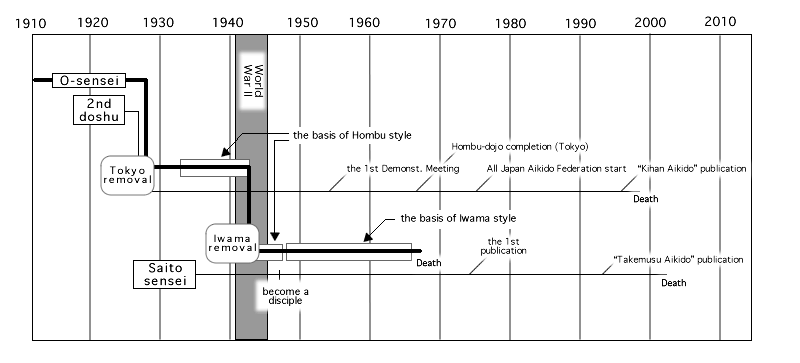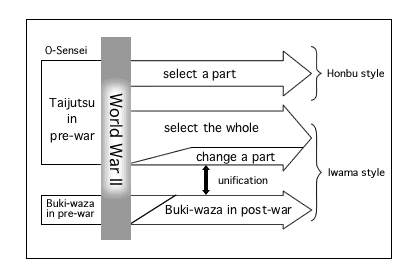Summary:
Based on O-sensei`s Aikido, Aikikai style is the style that the 2nd Doshu Kisshomaru Ueshiba sensei (1921-1999) organized, selecting part of the Ki-no-nagare (Flowing practice) aspect of techniques which O-Sensei developed until the beginning of the post-war period (1948).
In contrast Iwama style is the style that O-sensei refined in Iwama for twenty-four years after the war until his death in April 1969. Therefore Iwama style is more than twenty years newer and far more abundant in its content than Aikikai style.
First I would like to present an outline of the both styles for the readers' convenience. Today both styles are practiced in several organizations but the number of practitioners of Aikikai style is far greater than that of Iwama style.
| Aikikai style | Iwama style | |
|---|---|---|
| Center | The 3rd Doshu (Moriteru Ueshiba sensei — the grandson of O-sensei) | †The president of Iwama Shinshin Aiki Shurenkai (Hitohira Saito sensei - the son of Morihiro Saito sensei) |
| Organized timeline | 1945-1950 (after the war) | 1970-1975 (after the death of O-sensei) |
| Outline | The style that Kisshomaru Ueshiba sensei, the 2nd Doshu, organized, selecting part of the Ki-no-nagare aspects from O-sensei`s techniques that he taught in pre-war, mid-war and post-war (1930-1948). (Note 1) It was sorted and organized by Kisshomaru Ueshiba sensei. (Note 3) |
The style that Morihiro Saito sensei arranged composed of techniques that O-sensei taught in the post-war until his death (1946-1968). (Note 2) It was sorted and organized by Morihiro Saito sensei. (Note 3) |
| Feature | Only Taijutsu (Body Techniques) (Note 4) Only Ki-no-nagare (Flowing practice) (Note 7) |
Taijutsu and Buki-waza (Body and Weapons techniques) (Note 5) and (Note6) Katai-keiko (Solid practice) and Ki-no-nagare (Flowing practice) (Note 7) |
| The number of body techniques | About 50 (Kiso-waza and Kihon-waza — Basics) (Note 8) | More than 200 (Kihon-waza — Basics) (Note 8) |
| Philosophy | The harmonization between you and your partner | The harmonization on the basis of the absolute strength |
†Hitohira Saito sensei became independent of Aikikai in November, 2003 and established the Iwama Shinshin Aiki Shurenkai.
There are two important points on this list of which one should be careful.
One is that Iwama style is more than twenty years more advanced than Aikikai style because it includes both the Body and Weapons techniques that were taught by O-sensei in his last years. (See Note 1 and Note 2)
The other is that Iwama style is far more abundant in techniques than Aikikais style. This is natural because Iwama style is the whole of O-sensei`s Aikido and Aikikai style is but a part of it.
I would like to show a brief chronological table and a brief chart as follows in order to help the reader understand these points clearly.
Table: The Bases of Aikikai and Iwama Style Aikido

Note on map above
Note on chart above:
Aikikai style consists of the portion of O-sensei techniques that are rather easy and suitable for Ki-no-nagare. They were selected by the 2nd Doshu from many techniques O-sensei developed in pre-war period.
Iwama style consists of the whole range of techniques that O-sensei developed in pre-war as well as the post-war period. Moreover we can understand O-sensei revised his weapon techniques to his new form unified his body techniques in this period. Please refer to the third of Chapter 7 in detail.
When we consider the above two facts, we can recognize again the truth that Aikikai style is the 2nd Doshu's style. To reiterate the 2nd Doshu Kisshomaru sensei arranged and classified a part of O-sensei`s techniques developed until the early post war period (1948).
Iwama style represents O-sensei's techniques, the development of which he completed or refined during the twenty-four years in Iwama after war.
We often hear this evaluation in public: "Aikikai style is the flowing techniques of O-sensei's last years and Iwama style is the solid and rough techniques of O-sensei's early years." However now I believe the readers will understand that this evaluation is completely false.
I will describe in detail the historical circumstances of Japanese Aikido world at the post-war period in Chapter 6 including where O-sensei, the 2nd Doshu and Saito sensei were located and or living.
(Note 1) The Aikikai organization was established in February 1948 so Aikikai style uses as a starting base O-sensei's Aikido that he taught until that time. O-sensei continued to live in Iwama until his death in 1969. He made trips to Aikikai Hombu dojo and Kansai-area (around Osaka, Ayabe and Tanabe-his birthplace) to offer instruction in Aikido. I don't know whether or not the 2nd Doshu changed a part of his Aikikai style during this period but it is clear that he never adopted any Katai-keiko (Solid practice).
(Note 2) O-sensei died in April 1969 so Iwama style is composed of O-sensei's Aikido that he taught until his death. After O-sensei's death, Morihiro Saito sensei tried to convey O-sensei's techniques as they were taught to him. This he did until his death in 2002.
(Note 3) O-sensei's teaching method was that by watching carefully one learns well. There was little verbal explanation. Therefore both Kisshomaru sensei and Saito sensei had to name, arrange and classify the different techniques. For example, Tai-no-tenkan in Aikikai style is equal to Tai-no-henko in Iwama style.
(Note 4) Tanto-dori (Knife-taking), Tachi-dori (Sword-taking), Jo-dori (Stick-taking) and Jo-nage (Stick-throwing) are parts of the Body techniques, not the Weapons techniques. In Aikikai style Weapons techniques are considered as the application or optional techniques, not the basic and not compulsory. In some books of the 2nd Doshu wrote about the Weapons techniques but Aikikai style has no formal Weapons techniques today.
(Note 5) The Weapons techniques of Iwama style are a complete system that includes Suburi, Awase, Kumi-tachi, Kumi-jo and Ken-tai-jo. There are7 kinds of the basic Suburi of Tachi (Sword) and 20 kinds of the basic Suburi of Jo (Stick). Even beginners are taught the Weapons techniques.
In Iwama style the beginners will be taught throughout "the phased teaching method" step by step both Weapons and Bodytechniques.
(Note 6)"The phased teaching method" or "Step by step teaching method" is a historic teaching method by which the leaders should teach his/her beginners O-sensei's Aikido itself through their long training processes, 5 years, 10 years, 20 years and so long.
This is the outline of this method:
In Body techniques first they train Katai-keiko (Solid practice) of each tehniques. At that time the leaders shoulddecompose each technique into each movement one by one and teach the correct forms and the orders. If necessary, they can mumber each movement. After then they convert into Ki-no-nagre (Flowing practice).
In Weapons techniques are as same. First they train Suburi and then they train Awase (It also divides into two part, Bunkai (decomposition) and Awase (blending).) After then, they make progress Kumi-tachi, Kumi-jo and Ken-tai-jo.
O-sensei's techniques were too difficult to teach accurately and exactly to the general public. At some period just after his death, some of thehigh-ranking disciples implemented rather rude and rough instruction for beginners using physical strength. During thisperiod Iwama style was nicknamed "the powered Iwama style".
After Saito sensei continued to learn through trial and error for more than ten years after O-sensei's death, he realized itwas necessary to go back to the step by step movement of the basic techniques. At last he arrived the above creativeteaching method in 1980s.Since then Iwama style Aikido has become the style anyone can do and has started to spread all over the piblic. Strictly speaking even if anyone cannot do O-sensei's Aikido itself, but we can approach it as close as we train by this method. Saito sensei used to say at his last years "One who can stop the technique step by step is a skillful one."
In my opinion, this teaching method was brought in Weapon techniques first and after then it was applied also in Kataki-keiko of Body techniques.
(Note 7)Katai-keiko (Solid practice) is also called Tsukami-keiko (Grabbed Practice) and it is a training method for the Body techniques. It begins from a situation in which your partner firmly grabs your arm/wrist, chest or shoulder.
Ki-no-nagare (Flowing practice) is also called Yawarakai-keiko (Soft Practice) and entails a situation in which you and your partner move in harmony. There is only one kind of Ki-no-nagare in Aikikai style while in Iwama style there are two. One is the slow Ki-no-nagare (Flexible practice) and the other is the fast Ki-no-nagare (real Flowing practice). Please refer to the first of Chapter 7 in detail.
I can say that this phased practice (Solid → Flexible → Flowing) is "the phased teaching method" of the Body techniques of Iwama style
(Note 8) This is an expression for convenience. Kiso and Kihon are the same meaning in Japanese. However in the official book of Aikikai headquarters, "Kihan Aikido" (Kisshomaru and Moriteru sensei, Vol.1-1997 and Vol.2-2001—Kihan means Model or Standard)—English version "Best Aikido", basic techniques are sorted into two categories, Kiso-waza (the most basic about 10 techniques) and Kihon-waza (the second most basic 30-40 techniques). Therefore I used them for convenience of Aikikai Style practitioners. Kihon-waza is the only term used in Iwama style.
Well, I tried counting the number of the basic body techniques in the books "Kihan Aikido" and "Takemusu Aikido". The result is that "Kihan Aikido" (Aikikai style) has 51 basic body techniques while "Takemusu Aikido" (Iwama style) has 209.
